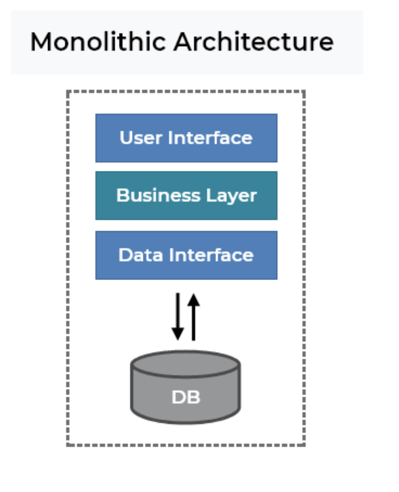While in our previous blog post we discussed the advantages of microservices for enterprises, in this post we will review the differences between the monolithic and microservices architecture.
Monolithic architecture
Monolithic architecture is seen as representing the status quo - an established method of creating apps.

A monolithic application is created as a single, integrated piece. A client-side user interface, a server
-side program, and a database often make up such a system. All functions are controlled and provided in a single, unified location.
Monolithic apps often have a single sizable code base and lack modularity. The same code base is accessed by developers when they wish to update or modify something. Thereby, they alter the entire stack at once, which sometimes can be risky and might require a downtime slot for maintenance.
According to a survey by Red Hat, 75% of enterprises still rely on monolithic applications.
Advantages of a Monolithic architecture over Microservices
Reduced cross-cutting issues
Cross-cutting concerns include logging, handling, caching, and performance monitoring that have an impact on the entire program. This functional area only affects one application in a monolithic program, making management simpler.
Seamless testing and debugging
Single-tiered apps are simpler to debug and test when comparing monolithic vs. microservices design. End-to-end testing can be completed significantly faster with monolithic apps since they function as a single, cohesive entity.
Fast and uncomplicated implementation
Monolithic apps require just one file or directory to be deployed, hence there are fewer deployments to manage.
Easier development
Most skilled engineers have the necessary knowledge to create a monolithic application as long as it is a common method of developing apps.
Are there drawbacks to a Monolithic architecture?
In short, yes.
May grow too large and become challenging to maintain
Initially, a project is simple to keep up with, but as time goes on, the size of the application may increase, making management more challenging. When the program is exceedingly large and sophisticated, a monolithic application may not function very well for small or medium applications.
Unavailable during deploying
The entire application is inaccessible when anything is changing or deployed in a monolith. A study by TechRepublic found that 39% of IT professionals consider monolithic architecture to be a significant challenge in their organization.
Highly interdependent components
Making modifications to such a vast, intricate, and tightly coupled program might be difficult. Each code change impacts the entire system, triggering technical difficulties and demanding careful planning.
Reduced scalability
Monoliths can scale - but it is only feasible to scale the complete application. If a single area of the application receives an excessive number of requests, you will need to scale the entire program rather than just that area. Moreover, using horizontal scaling is not always practicable; instead, vertical scaling, which is typically more costly, will be required.
Limited flexibility
Monoliths may limit you to the technology you have initially selected, since it’s challenging to swap technologies in a monolith application. As a result, once a monolith is developed, it probably won't change for many years. A report by DZone found that 49% of developers believe that monolithic architecture hinders their ability to deliver software quickly.
When is a monolithic architecture ideal?
A monolithic design is particularly useful in a variety of situations, including:
- when you are aware that the application will not be particularly large
- when you are unsure about the precise nature of the application, for instance, if the requirements are vague or the domain is unfamiliar to you or your team.
- when you have a proof-of-concept project
- when the domain is brand-new, and your team is small or has just started working together
- when the app has only a few business rules.
Microservices
With a microservice architecture, the application is divided into smaller services that are loosely connected, independent of one another, and equipped with their own databases.
Technically speaking, microservices provide a single business/technical function of the applications they encompass through several little services. It becomes a distributed system when many microservices connect with one another via API endpoints or HTTP protocols - Adrian Tudoran, VP of Engineering.

The whole functionality is divided into independently deployable modules inside a microservices architecture, and these modules can communicate with one another via either message brokers or specified interfaces known as APIs. Each service has a distinct scope and can be deployed, scaled, and upgraded separately.
More advantages of a Microservice architecture
- Flexible scaling allows for autonomous scaling of each microservice. When the application must have high availability, microservices come in helpful.
- Remove the "single point of failure" in the application by splitting it out into several small services.
- Reduces the likelihood that the app will become unusable – If a microservice becomes unusable, the other elements of the program will continue to function as intended without being impacted.
- Can be changed easily — As a microservice is often not a large program, it is simpler to update the microservice's framework or make changes to the code.
- Work with several teams is streamlined since each team may oversee a single microservice or a collection of microservices, dividing up the project's various responsibilities among the teams.
- Easier to understand and extend. A smaller program is typically easier to comprehend than a larger application and adding more microservices is simpler.
When is a Microservices architecture ideal?
A microservices architecture can be useful in a variety of situations, including:
- When you anticipate that the application will expand significantly and become extra-large
- When you are aware of the software's domain and business rules, or when the requirements are clearly laid out and it is easy to determine that the application will be difficult
- When a large, complicated, and old application is rewritten by the team
- When an application's needs include availability and flexible scalability while collaborating with various teams and a reputable domain
How are Microservices helping CIOs achieve IT and business alignment?
Organizational growth is thought to be significantly accelerated by alignment between business and IT. To remain inventive and competitive, the emphasis has switched from "alienating" to "collaborating" between IT processes and business goals.
What, in today's extremely competitive industrial world, is assisting enterprises in realizing IT and business alignment? Answer: Microservices.
Underpinning Business-IT Alignment using Microservices
Business-IT alignment is an essential choice that requires full ownership and CIOs are the ideal candidates since they enhance essential IT features and support corporate goals.
Microservices for Business-IT alignment needs CIOs to rethink the architectural landscape and create a culture where teams collaborate on autonomous activities. Targeting and enabling IT automation reduces manual procedures and boosts productivity.
A well-planned effort of all key drivers will unlock microservices' full potential. This is where Kubeark comes in. Businesses may immediately deploy solutions to any environment using this architecture while also modifying it to meet their own needs. In this way, they are better equipped to manage changing demand and scale up or down without affecting operations.
With Kubeark, CIOs help their companies gain:
- Game-changing scalability: the Kubeark platform allows having functionally modular components with distinct business goals which enable companies to improve one IT architecture component without affecting the rest.
- Increased autonomy: Kubeark lets development and operational teams work independently toward a common objective, which fosters a collaborative, innovative, and evolving workplace.
- Instant deliverability: the Kubeark platform enable teams to construct business-friendly apps, which increase operational flexibility and speed.
The adoption of microservices architecture by major tech companies like Uber, Netflix, and Amazon, and the support it has received from analysts, tech influencers and business stakeholders, has made it clear that microservices are a key component of the modern businesses.
However, enterprises must recognize that transitioning from a Monolithic program to a Microservices architecture is a complex and time-consuming process that may require multiple iterations. Architects and developers must thoroughly evaluate each component of the monolith and devise a migration strategy for each one.
Moreover, with the emergence of platforms like Kubeark, the choice of architecture is not just a technical decision but also a strategic one. In this new reality, CEOs, CTOs, and CIOs must seek out platforms that provide a competitive advantage, such as speed, the latest integrations, and the most innovative approaches.
As a result, the businesses that can effectively leverage microservices architecture will be well-positioned to succeed in a rapidly evolving business landscape.
Get in touch with our team and see for yourself how you can change the game.

